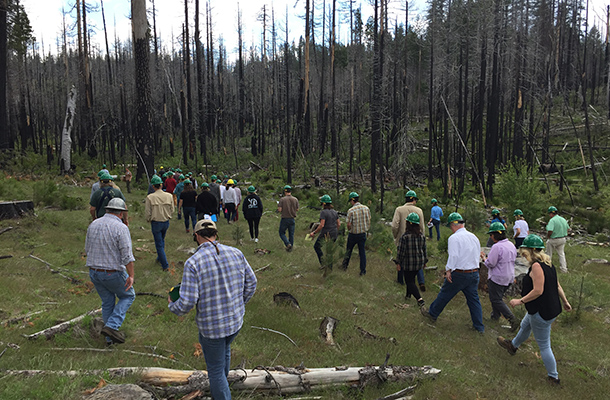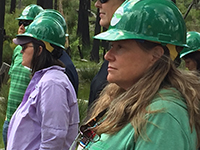
Participants of the Rim Fire Forest Resilience Tour (Photo: Deb Kollars/CAFwd)
The challenges of managing California’s forests for public safety and ecosystem health were on full display during a tour of forested lands scarred by the 2013 Rim Fire. Hosted by the Sierra Nevada Conservancy, the Rim Fire Forest Resilience Tour on May 30 took 80 participants through some of California’s most breathtaking but battered High Sierra landscapes within the Stanislaus National Forest in Tuolumne County.
The tour included board members and staff of the Conservancy, as well as nonprofit leaders, elected officials, scientists, environmental stewards, timber industry members and firefighting experts. The goal was to foster conversation and understanding around the complexities and management of post-fire lands. The daylong field trip featured a striking array of landscapes, including mountains, meadows, canyons, rivers and streams. Along the way, those participating came face to face with long stretches of scorched trees, lands struggling to regenerate, and piles of burned vegetative debris along the roadsides.
The Rim Fire ignited in August of 2013 and ultimately burned more than 257,000 acres. Of those, 154,314 were in the Stanislaus National Forest, 78,895 in Yosemite National Park, and the remainder on private or other public lands. The Rim Fire became the largest fire to ever burn in the Sierra Nevada at the time. Its size and speed as it spread was unprecedented in the Sierra, and served as a warning of the megafires to come in California due to overgrown forests and a changing climate.
During the tour, Louise Bedsworth, executive director of the Strategic Growth Council, described the successful joint effort of the state and other entities to secure $70 million in federal Department of Housing and Urban Development (HUD) funding through the National Disaster Resilience Competition (NDRC). The competition invited communities throughout the U.S. that had experienced natural disasters to compete for funds to assist in rebuilding and increase resilience to future disasters.
“The state wanted to participate,” Bedsworth said. “We focused on the Rim Fire.”
 California’s NDRC award will fund the Community and Watershed Resilience Program, which is designed to address unmet recovery needs in Tuolumne County from the Rim Fire. The program has three prongs: Forest and watershed health, community resilience centers, and a biomass utilization facility. Work began in the spring of 2019 and will run through 2022. The grant was secured through a partnership that included the Governor’s Office of Planning and Research, several other state entities, the U.S. Forest Service, Tuolumne County, and the Sierra Nevada Conservancy. The Sierra Nevada Conservancy is a state agency created in 2004 to improve the environmental, economic and social well-being of the Sierra Nevada region.
California’s NDRC award will fund the Community and Watershed Resilience Program, which is designed to address unmet recovery needs in Tuolumne County from the Rim Fire. The program has three prongs: Forest and watershed health, community resilience centers, and a biomass utilization facility. Work began in the spring of 2019 and will run through 2022. The grant was secured through a partnership that included the Governor’s Office of Planning and Research, several other state entities, the U.S. Forest Service, Tuolumne County, and the Sierra Nevada Conservancy. The Sierra Nevada Conservancy is a state agency created in 2004 to improve the environmental, economic and social well-being of the Sierra Nevada region.
During the tour, organizers and participants highlighted the significant role that Yosemite Stanislaus Solutions, an independent collaborative group, has played in helping to secure the NDRC grant funding and to implement the program. Known as YSS, this group consists of representatives of the timber industry, grazing interests, local government, environmental organizations, business interests, motorized recreation groups, state and federal agencies, and other diverse interests. YSS has used a collaborative process to promote recommendations and actions to implement in the 402 square miles of the Rim Fire area. The group is dedicated to restoring and maintaining healthy forests and watersheds, fire-safe communities and sustainable local economies using a science-based approach.
At various stops, scientists from the U.S. Forest Service and other institutions described the growing consensus around the need for using fuel treatments, including prescribed burns and mechanical thinning within burned areas, to reduce the threat of future wildfires and help create more healthy and resilient forests. Among those who spoke was Brandon Collins, a research scientist with the U.S. Forest Service Pacific Southwest Research Station and the UC Berkeley Center for Fire Research and Outreach.
 “These forests are severely departed from what they were historically,” Collins said, explaining the need for such fuel treatments. At the same time, he noted the increase in severe large wildfires. “We’re seeing fire severity at a scale we’ve never seen.”
“These forests are severely departed from what they were historically,” Collins said, explaining the need for such fuel treatments. At the same time, he noted the increase in severe large wildfires. “We’re seeing fire severity at a scale we’ve never seen.”
Some participants pointed to green growth within burned trees stands and contended that the forests should be allowed to regenerate on their own and naturally without such management practices. Among other things, they expressed concern about losing trees that serve as habitat for wildlife.
However, many others expressed deep concern that the pace and scale of fuel treatments must be accelerated, not stopped, to protect communities, forests, watersheds, air quality, and ecosystems. Near the end of the tour, speakers described the dire conditions in forests and need for collaboration and action.
Angela Avery, executive director of the Sierra Nevada Conservancy, for example, pointed to the NDRC grant project, which the Conservancy is helping to administer. Aided by YSS, the project serves as a significant example of diverse interests coming together to reach consensus, despite differing perspectives, for the broad goal of public safety and forest resiliency.
Hugh Safford, regional ecologist for the USDA Forest Service’s Pacific Southwest Region, noted that when the Rim Fire occurred, it was so large and shocking that “some people saw it as an anomaly.” But many others, he said, saw it differently, as a sign of the trend to come.
Indeed, since the Rim Fire, catastrophic wildfires have continued to strike the state with increasing frequency and severe impacts, including the 2018 Camp Fire in Butte County that extinguished the town of Paradise and the 2017 Tubbs Fire in Sonoma County that devastated portions of that area’s wine country and suburban communities.
The California Economic Summit’s Elevate Rural CA initiative has identified the wildfire crisis as a key focus area for safeguarding fire-prone landscapes, rural communities, and the overall economy of California. While green growth was apparent and encouraging to see in many places on the tour in Tuolumne County, the many acres of scorched trees and soil from the Rim Fire also stood as a strong reminder that California has a challenging path ahead in managing its vast and valuable forested lands.

